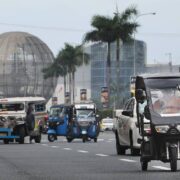After bumpy start, new ride-hailing app seeks inroads into PH

Ride-hailing company InDrive does not intend to topple down market leader Grab Philippines, which has been cornering the four-wheel segment for several years now. When InDrive established a local presence last year, its goal was simple and grounded: to become a reliable alternative for Filipinos.
Roman Ermoshin, InDrive director of Asia-Pacific Region, stresses the need to provide customers more options when it comes to transportation services amid the increasing mobility postpandemic.
In the Philippines, for example, Ermoshin says passengers who do not have private cars only rely on one ride-hailing platform to go in and out of Ninoy Aquino International Airport for their flights. This poses a problem in case a user finds technical difficulties with the app for whatever reason, he says. So, what then?
Apart from this, passengers already find it challenging to book a ride going out of the international gateway given the high demand.
This is where InDrive comes in, says Ermoshin, who was born in Russia, where InDrive has its roots.
“To be honest, we’re not planning to become number one. We know Grab’s ecosystem here,” Ermoshin humbly tells the Inquirer. The super app operator headquartered in Singapore has been dominating the local ride-hailing market since 2018 after purchasing rival Uber.
“We’re just going to be second alternative to them and give options to drivers and passengers to choose between us and Grab,” Ermoshin says.
“That’s fine,” he continues, acknowledging the company always has competitors in all the markets where it is available. “Competition is always good.”
Price-haggling
The selling point of the ride-hailing company—whose franchise was just approved in December last year—is having cheaper services compared with competitors. It even allows price haggling with customers.
This pricing scheme, implemented across 46 countries, is seen to make the company “unique.”
However, the price haggling feature was not well-received in the Philippines. The Land Transportation Franchising and Regulatory Board suspended its operations in January because of this.
This feature allowed passengers to negotiate for cheaper prices but it also meant lower revenues for the drivers. It was against the fare matrix scheme being followed by local transportation network vehicle service operators. Such matrix scheme considers flag-down rate, per-kilometer, per-minute and surge fees in the fare computation.
In response, InDrive has removed this feature from the app to comply with local regulations. The company finally got the go signal to resume operations just last month.
Even then, Ermoshin says they can still offer cheaper fares compared with competitors because they charge driver commission fees below 10 percent, lower than the 20-percent industry average.
PH a good market
While it was a bumpy start for InDrive, Ermoshin remains optimistic about their prospects in this market where there is still room for more players servicing the needs of customers.
He observes that Filipino users are already very knowledgeable when it comes to using the app, given their experience with transacting with Grab.
“Users are very educated. The customers are very digitalized. Everyone has a lot of apps installed,” he says.
“People are ready to try something new,” he adds.
Ermoshin shares that customers also appreciate that their app is easy to use as it only focuses on transportation. It is not a super app that features a variety of services, he notes.
“It is the advantage of the app. It is an easy ride-hailing app, without any ecosystem and ad. It is not a super app,” he says.
The app allows its users to select preferred drivers based on driver rating, vehicle model and estimated time of arrival. At the same time, drivers can also choose their passengers according to pickup point, destination and fare.
Plans for future
InDrive targets to enlist about 20,000 drivers in the National Capital Region by the end of the year. Outside the capital, it aims to have 3,000 drivers within the same period.
Currently, it has about 6,000 partner-drivers who are mostly plying the routes of Metro Manila. Others are in the provinces including Bacolod, Baguio and Cagayan.
InDrive, in relation to this, has teamed up with local transport group Laban TNVS to grow the number of its partner-drivers.
“Our members will benefit from the partnership, especially since InDrive has the lowest service charge in the market. Now, our partner drivers can take home more of their earnings to their families,” Laban TNVS president Jun De Leon says.
Ermoshin says they also plan to eventually enter the two-wheel segment but the company needs to secure franchise first before doing so. This segment’s main players are Angkas, JoyRide and MoveIt.
“It makes the traffic less intense because people can move with smaller means of transportation,” he explains.
InDrive, founded in 2013, has presence in over 600 cities across five continents.

















